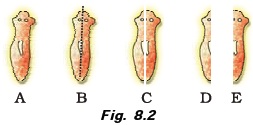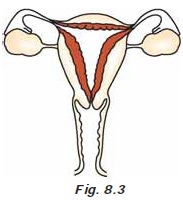Candidates can download NCERT Exemplar Class 10 Science Unit 8 from this page. The exemplar has been provided by the National Council of Educational Research & Training (NCERT) and the candidates can check it from below for free of cost. It contains objective, very short answer type, short answer type, and long answer type questions. Along with it, the answer for each question has also been provided. From the NCERT Exemplar Class 10 Science Unit 8, candidates can understand the level and type of questions that are asked in the exam.
NCERT Exemplar Class 10 Science Unit 8 How Do Organisms Reproduce
NCERT Class 10 Science Unit 8 is for How Do Organisms Reproduce. The type of questions that will be asked from NCERT Class 10 Science Unit 8 are displayed in the below provided NCERT Exemplar Class 10 Science Unit 8. With the help of it, candidates can prepare well for the examination.
Also Check: NCERT Solutions for Class 10 Science
Multiple Choice Questions
- In the list of organisms given below, those that reproduce by the asexual method are
(i) banana
(ii) dog
(iii) yeast
(iv) Amoeba
(a) (ii) and (iv)
(b) (i), (iii) and (iv)
(c) (i) and (iv)
(d) (ii), (iii) and (iv) - In a flower, the parts that produce male and female gametes (germ cells) are
(a) stamen and anther
(b) filament and stigma
(c) anther and ovary
(d) stamen and style - Which of the following is the correct sequence of events of sexual reproduction in a flower?
(a) pollination, fertilisation, seedling, embryo
(b) seedling, embryo, fertilisation, pollination
(c) pollination, fertilisation, embryo, seedling
(d) embryo, seedling, pollination, fertilisation - Offspring formed by asexual method of reproduction have greater similarity among themselves because
(i) asexual reproduction involves only one parent
(ii) asexual reproduction does not involve gametes
(iii) asexual reproduction occurs before sexual reproduction
(iv) asexual reproduction occurs after sexual reproduction
(a) (i) and (ii)
(b) (i) and (iii)
(c) (ii) and (iv)
(d) (iii) and (iv) - Characters transmitted from parents to offspring are present in
(a) cytoplasm
(b) ribosome
(c) golgi bodies
(d) genes - Characters that are transmitted from parents to offspring during reproduction show
(a) only similarities with parents
(b) only variations with parents
(c) both similarities and variations with parents
(d) neither similarities nor variations - A feature of reproduction that is common to Amoeba, Spirogyra and Yeast is that
(a) they reproduce asexually
(b) they are all unicellular
(c) they reproduce only sexually
(d) they are all multicellular - In Spirogyra, asexual reproduction takes place by
(a) breaking up of filaments into smaller bits
(b) division of a cell into two cells
(c) division of a cell into many cells
(d) formation of young cells from older cells. - The ability of a cell to divide into several cells during reproduction in Plasmodium is called
(a) budding
(b) reduction division
(c) binary fission
(d) multiple fission - The correct sequence of reproductive stages seen in flowering plants is
(a) gametes, zygote, embryo, seedling
(b) zygote, gametes, embryo, seedling
(c) seedling, embryo, zygote, gametes
(d) gametes, embryo, zygote, seedling - The number of chromosomes in parents and offsprings of a particular species remains constant due to
(a) doubling of chromosomes after zygote formation
(b) halving of chromosomes during gamete formation
(c) doubling of chromosomes after gamete formation
(d) halving of chromosomes after gamete formation - In Rhizopus, tubular thread-like structures bearing sporangia at their tips are called
(a) filaments
(b) hyphae
(c) rhizoids
(d) roots - Vegetative propagation refers to formation of new plants from
(a) stem, roots and flowers
(b) stem, roots and leaves
(c) stem, flowers and fruits
(d) stem, leaves and flowers - Factors responsible for the rapid spread of bread mould on slices of bread are
(i) large number of spores
(ii) availability of moisture and nutrients in bread
(iii) presence of tubular branched hyphae
(iv) formation of round shaped sporangia
(a) (i) and (iii)
(b) (ii) and iv)
(c) (i) and (ii)
(d) (iii) and (iv) - Length of pollen tube depends on the distance between
(a) pollen grain and upper surface of stigma
(b) pollen grain on upper surface of stigma and ovule
(c) pollen grain in anther and upper surface of stigma
(d) upper surface of stigma and lower part of style - Which of the following statements are true for flowers?
(i) Flowers are always bisexual
(ii) They are the sexual reproductive organs
(iii) They are produced in all groups of plants
(iv) After fertilisation they give rise to fruits
(a) (i) and (iv)
(b) (ii) and (iii)
(c) (i) and (iii)
(d) (ii) and (iv) - Which among the following statements are true for unisexual flowers?
(i) They possess both stamen and pistil
(ii) They possess either stamen or pistil
(iii) They exhibit cross pollination
(iv) Unisexual flowers possessing only stamens cannot produce fruits
(a) (i) and (iv)
(b) (ii), (iii) and (iv)
(c) (iii) and (iv)
(d) (i), (iii) and (iv) - Which among the following statements are true for sexual reproduction in flowering plants?
(i) It requires two types of gametes
(ii) Fertilisation is a compulsory event
(iii) It always results in formation of zygote
(iv) Offspring formed are clones
(a) (i) and (iv)
(b) (i), (ii) and (iv)
(c) (i), (ii) and (iii)
(d) (i), (ii) and (iv) - In Figure 8.1, the parts A, B and C are sequentially

(a) cotyledon, plumule and radicle
(b) plumule, radicle and cotyledon
(c) plumule, cotyledon and radicle
(d) radicle, cotyledon and plumule - Offspring formed as a result of sexual reproduction exhibit more variations because
(a) sexual reproduction is a lengthy process
(b) genetic material comes from two parents of the same species
(c) genetic material comes from two parents of different species
(d) genetic material comes from many parents - Reproduction is essential for living organisms in order to
(a) keep the individual organism alive
(b) fulfill their energy requirement
(c) maintain growth
(d) continue the species generation after generation - During adolescence, several changes occur in the human body. Mark one change associated with sexual maturation in boys
(a) loss of milk teeth
(b) increase in height
(c) cracking of voice
(d) weight gain - In human females, an event that reflects onset of reproductive phase is
(a) growth of body
(b) changes in hair pattern
(c) change in voice
(d) menstruation - In human males, the testes lie in the scrotum, because it helps in the
(a) process of mating
(b) formation of sperm
(c) easy transfer of gametes
(d) all the above - Which among the following is not the function of testes at puberty?
(i) formation of germ cells
(ii) secretion of testosterone
(iii) development of placenta
(iv) secretion of estrogen
(a) (i) and (ii)
(b) (ii) and (iii)
(c) (iii) and (iv)
(d) (i) and (iv) - The correct sequence of organs in the male reproductive system for transport of sperms is
(a) testis → vasdeferens → urethra
(b) testis → ureter → urethra
(c) testis → urethra → ureter
(d) testis → vasdeferens → ureter - Which among the following diseases is not sexually transmitted?
(a) Syphillis
(b) Hepatitis
(c) HIV – AIDS
(d) Gonorrhoea
Short Answer Type Questions
- In a bisexual flower inspite of the young stamens being removed artificially, the flower produces fruit. Provide a suitable explanation for the above situation.
- Can you consider cell division as a type of reproduction in unicellular organism? Give one reason.
- What is a clone? Why do offsprings formed by asexual reproduction exhibit remarkable similarity?
- Explain how, offspring and parents of organisms reproducing sexually have the same number of chromosomes?
- Colonies of yeast fail to multiply in water, but multiply in sugar solution. Give one reason for this.
- Why does bread mould grow profusely on a moist slice of bread rather than on a dry slice of bread?
- Give two reasons for the appearance of variations among the progeny formed by sexual reproduction.
- Would a Planaria cut vertically into two halves regenerate into two individuals? Complete Figure 8.2 D and E by indicating the regenerated regions.

- From the internet, gather information about the chromosome numbers of five animals and five plants. Correlate the number with the size of organism and answer the following questions.
(a) Do larger organisms have more number of chromosomes/cells?
(b) Can organism with fewer chromosomes reproduce more easily than organisms with more number of chromosomes?
(c) More the number of chromosomes/cells greater is the DNA content. Justify. - In tobacco plant, the male gametes have twenty four chromosomes. What is the number of chromosomes in the female gamete? What is the number of chromosomes in the zygote?
- Why cannot fertilisation take place in flowers if pollination does not occur?
- Is the chromosome number of zygote, embryonal cells and adult of a particular organism always constant? How is the constancy maintained in these three stages?
- Where is the zygote located in the flower after fertilization?
- Reproduction is linked to stability of population of a species. Justify the statement.
- How are general growth and sexual maturation different from each other?
- Trace the path of sperm during ejaculation and mention the gland and their functions associated with the male reproductive system.
- What changes are observed in the uterus if fertilisation does not occur?
- What changes are observed in the uterus subsequent to implantation of young embryo?
- What are the benefits of using mechanical barriers during sexual act?
- In the given Figure 8.3 label the parts and mention their functions

- What would be the ratio of chromosome number between an egg and its zygote? How is the sperm genetically different from the egg?
Long Answer Type Questions
- Why are budding, fragmentation and regeneration all considered as asexual types of reproduction? With neat diagrams explain the process of regeneration in Planaria.
- Write two points of difference between asexual and sexual types of reproduction. Describe why variations are observed in the offspring formed by sexual reproduction.
- Distinguish between pollination and fertilisation. Mention the site and product of fertilisation in a flower.
Draw a neat, labelled diagram of a pistil showing pollen tube growth and its entry into the ovule. - Distinguish between a gamete and zygote. Explain their roles in sexual reproduction.
- Draw the diagram of a flower and label the four whorls. Write the names of gamete producing organs in the flower.
- What is placenta? Mention its role during pregnancy?
- What are various ways to avoid pregnancy? Elaborate any one method.
- How does fertilisation take place? Fertilisation occurs once in a month. Comment.
- Reproduction is essentially a phenomenon that is not for survival of an individual but for the stability of a species. Justify.
- Describe sexually transmitted diseases and mention the ways to prevent them.
| « Previous | Next » |
Answers
Multiple Choice Questions

Short Answer Questions







Long Answer Questions
To get study material, exam alerts and news, join our Whatsapp Channel.









